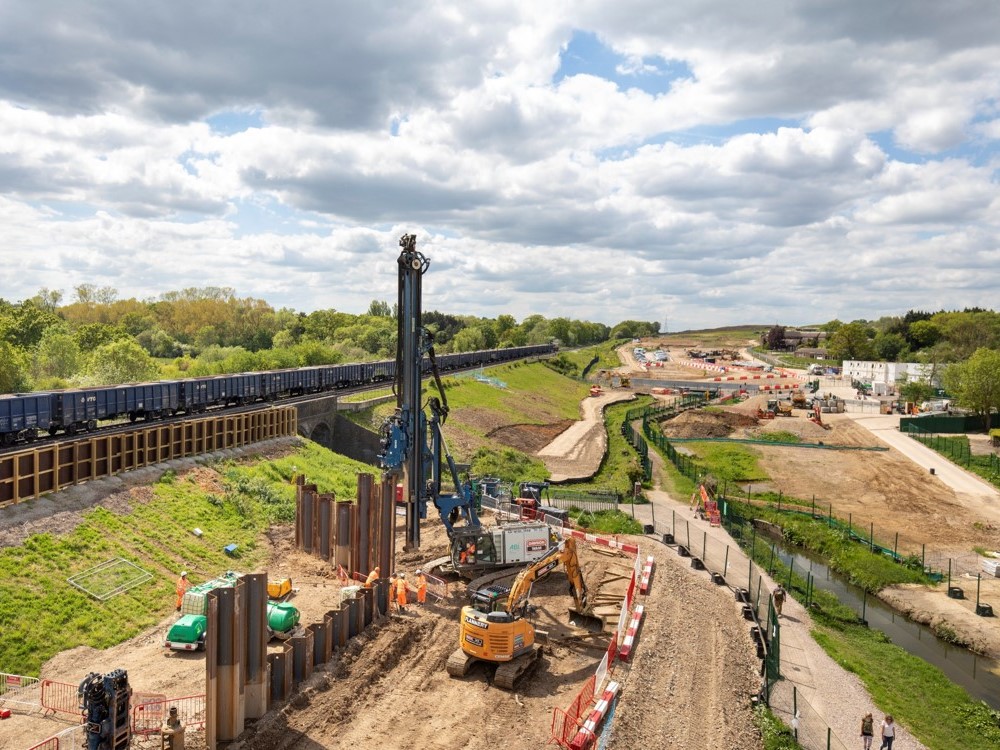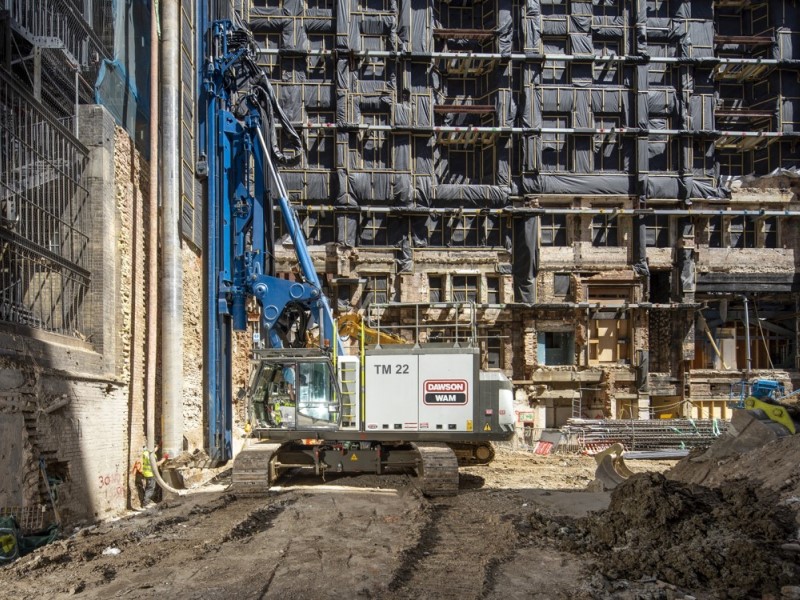London: Farringdon Road Premier Inn
PROJECT DETAILS
CLIENT:
Premier Inn
DESIGN ENGINEER:
Card Geotechnical Limited (CGL)
MAIN CONTRACTOR:
Gilbert-Ash
PROCUREMENT ROUTE:
JCT
LOCATION:
London
DAWSON-WAM Ltd. was awarded the complex construction sub-contract by client Gilbert-Ash to transform an existing multi story NCP car park on Farringdon Road, into a new commercial development and hotel. The intricate and sustainable foundation design for the new development was based on utilising the existing bearing piles of the car park, complimented by newly installed CFA bearing piles.
To add further complexity to the ambitiously sustainable design, the Clerkenwell tunnel, a live asset of Network Rail, was situated directly under the centre of the site footprint; along with the live Metropolitan London Underground tunnel, which was immediately adjacent to the Farringdon Road site. Both live tunnels burdened construction exclusion zones, preventing large areas within the site from being utilised for permanent or temporary construction works.
The scope of the works package included:
- Extensive preliminary design and value engineering with our client through early contractor involvement (ECI).
- Static testing of existing piles, which are scheduled to be utilised within the design of the new structure.
- Design and installation of new load bearing piles, 900mm in diameter, and 32m.
- Design and installation of temporary sheet piled retaining walls, to allow reduced excavations to accommodate the construction of new basement and ground beams.
- Design and installation of temporary propping to accompany the sheet piled retaining wall design.
Through liaising with our client Gilbert-Ash regarding the static testing of the existing piles, it was evident options were limited on which piles could be utilised. Many of the existing piles were situated parallel to the Clerkenwell tunnel on the perimeter of the exclusion zone, providing no scope to install reaction piles to accommodate static testing to 800T. Also, the ground beams and RC structure of the existing car park were still present, and could not be removed until temporary retaining walls were installed later in the construction programme, providing further restrictions on pile choice, and available reaction pile locations.
Through extensive collaboration between our geotechnical designer CGL, Network Rail, and specialist test engineers NDT, two piles were selected for testing and these piles were extended to ground level, which providing sufficient working space to erect the large static testing equipment. Detailed coordination with the demolition subcontractor allowed isolated pockets of the existing structure to be removed and be replaced with design approved compacted material to accommodate the installation of reaction piles. Eight reactions piles of 450mm diameter were installed to accommodate a static test to 800T, whilst four of 600mm diameter were installed to accommodate a static test to 525T.
Following the completion of the static testing, we mobilised our Soilmec SF 120 through an approved exemption with NRMM, to install new load bearing piles, 900mm in diameter, and 32m in depth. Prior to site mobilisation, Work Package Plans (WPP) were compiled and issued to client Gilbert-Ash for their review. A design report was issued by our designer CGL for the bearing piles, along with a Tunnel Impact Assessment, detailing out the negligible effect the skin friction would have on the neighbouring tunnel assets, providing confidence throughout all governing parties within the contract.. All documentation undertook a rigorous review process. CAT II and CAT III checks were required, along with third party approval and acceptance by both Network Rail and London Underground.
To facilitate the installation of the new load bearing piles, further collaboration with the demolition contractor and structural designer was required to agree on the removal of isolated sections of old ground beams and slabs, ensure localised, and suitably sized ‘pockets’ within the existing ground structure were provided.
Through the successful demolition of these areas, along with the removal of unforeseen RC structures and crane bases, all new bearing piles were installed, under supervision of Network Rail, with no issue.
With typical London clay conditions, the underground tunnel risk, and surrounding dwellings and business’, we provided the client with a vibrationless method to install the 160 linear meters of temporary sheet piled retaining walls. These walls were being utilised as temporary works to shore the surrounding ground to allow the excavation and construction of new ground structures. We mobilised a RTG 21 which utilised a quick docking system between attachments. We were able to pre-auger the ground, pitch the piles, and install to level utilising three separate attachments, providing our client with a quick and risk-free solution. Throughout all aspects of the pile installation, third party surveying and monitoring of the tunnel was undertaken, with data reported daily to site.
Upon the completion of the sheet pile installation, we proceeded to design the temporary propping following on from a detailed design at the ECI stage. Through further 3D design and digital rehearsals, along with gaining an understanding of the ground workers phasing of the new structure, we redesigned the propping layout from the initial design to both provide more head space for excavators, along with replacing raking props and thrust blocks with a combination of heavier waler beams, and back-propped corners with DYWIDAG bars; further providing a clear working area with no restrictions.
The completion of the propping install provided the client with adequate working space to complete the global reduced excavation of 3m within the cofferdam, then a further 2m to accommodate all new ground beams for their basement structure.
All works were complete to budget, ahead of time and without incident or issue.



